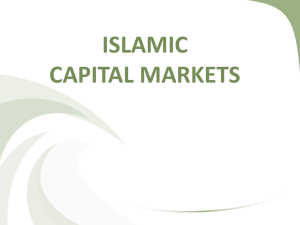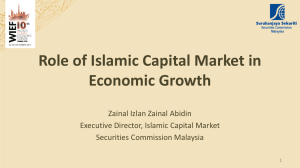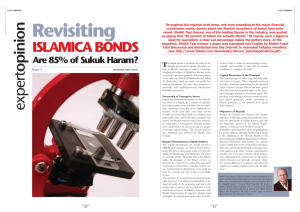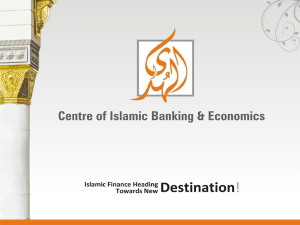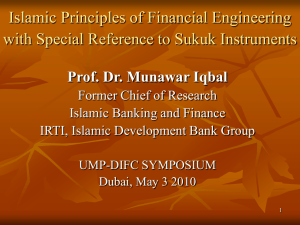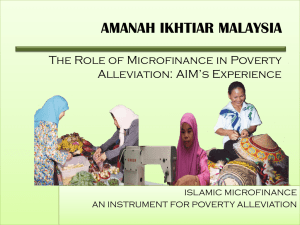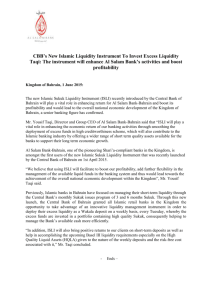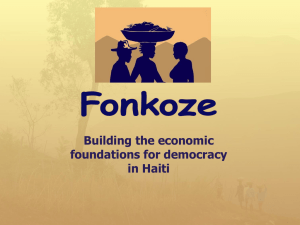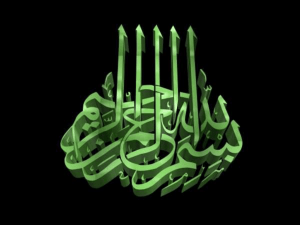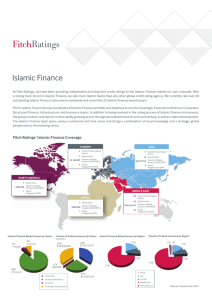A Propose Regulatory Framework for Liquidity issue in Indonesia
advertisement
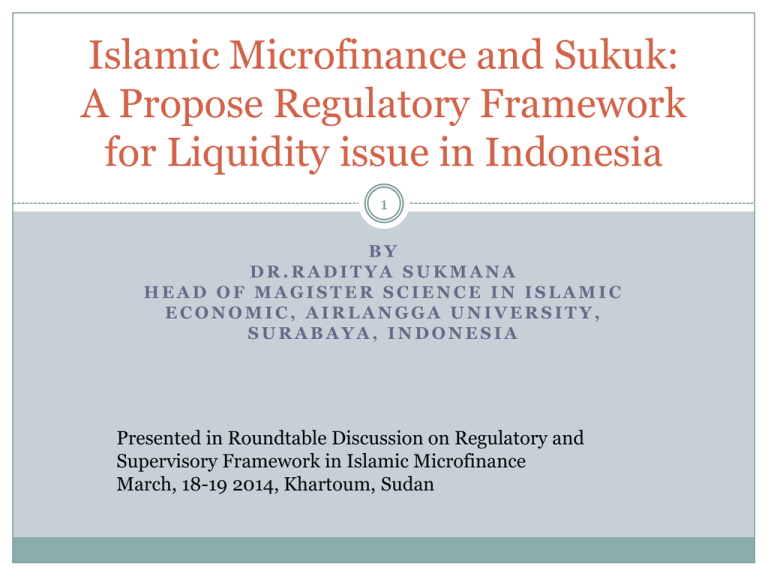
Islamic Microfinance and Sukuk: A Propose Regulatory Framework for Liquidity issue in Indonesia 1 BY DR.RADITYA SUKMANA HEAD OF MAGISTER SCIENCE IN ISLAMIC ECONOMIC, AIRLANGGA UNIVERSITY, SURABAYA, INDONESIA Presented in Roundtable Discussion on Regulatory and Supervisory Framework in Islamic Microfinance March, 18-19 2014, Khartoum, Sudan Map of Indonesia 2 Notes (various sources): 1. Total Population 230 million (2011) 2. % muslim = 88% 3. GDP per capita = $ 3464 4. Five biggest island: 1. JAVA 2. KALIMANTAN 3. SUMATERA 4. SULAWESI 5. PAPUA 5. Exchange rate (Rupiah-Rp) USD 1 = Rp 11000 Empirical data about the microfinance ( dept of cooperative-year 2010) 3 No Indicator Unit Numbers of Unit Unit Numbers Share 1 MSMEs Unit 53,823,732 99,99 2 Micro Unit 53,207,500 98,85 3 Small Unit 573,601 1,07 4 Medium Unit 42,631 0,08 Empirical data about the microfinance ( dept of cooperative-year 2010) 4 Number of Labor Person (unit) Numbers Share 1 MSMEs Person 99,401,775 97,22 2 Micro Person 93,014,759 90,98 3 Small Person 3,627,164 3,55 4 Medium Person 2,759,852 2,7 what are the most types of risks and challenges facing microfinance in the country? 5 Human resources fair treatment for the commercial banks and to microfinance programs. Risk appear from non business related issue such as member of the family got sick, harmony within the family mindset of the management staff and the owner or the member Many financial institution coming enter the microfinance Liquidity issue In Islamic microfinance institution Problem with Liquidity by IMFI 6 Linkage with Islamic bank high rate/margin Funds by Ministry sustainability of program Alternatively, adopts the Sukuk instruments Previous Study 7 sukuk mudharabah which has been applied in one of the state of Malaysia namely Johor a municipal called Pasir Gudang (PG). In 1995 this municipal wanted to raise fund to beautify the city. The local government then made use of the sukuk mudharabah for that purpose with the tax revenue stream as the underlying asset Sukuk for Microfinance: Proposed Structure 8 The process 9 1 SPV, set up a profit sharing basis of mudharabah with the investors. This means that the investors act as the rabbul maal (parties which have excess funds) and SPV act as the entrepreneur who will manage the funds. 2n3As a rabbul maal, investors contribute fund to be given to SPV and receive sukuk certificate 4 The ijarah part will take place between SPV and Govt as the owner of the asset 5 The govt asset is rented to the SPV. 6 SPV give rental fee (advanced payment) to the govt. This fee is coming from the funds contributed by the investors. 7 During the leased period, the profit generated from the leased asset will be managed by the SPV The process 10 8 The profit will then be given periodically to the investors as the profit form the partnership (mudharabaha) Basically, it requires eight sequence step in order for the sukuk to be implemented. These steps cover from where the funds come from until the step where the fund is given to CBL like for microfinance. However, this structure has not explained the main purpose of this study that is how sukuk can support the liquidity shortage for Islamic cooperatives (BMTs) which deal with Islamic microfinance. The following is the process on the role of sukuk for microfinance: 9 The advanced payment received by government is to be given to CBL that act as lender of the last resort for Islamic cooperatives. 10 The funds will then be distributed to the Islamic cooperative or BMTs. 11 As the price of the sources of funds is relatively cheap, BMTs will be more able to give lower financing rate to the MSMEs. Moreover as the loanable fund increase. BMTs have more opportunity to provide more financing 12 The profit from the businesses will be distributed between the MSMEs themselves as well as the BMTs. 13 Profit portion for the BMTs will be divided by the BMTs themselves and the CBL. The payment will be the profit portion for the CBL and this has been agreed upfront. There are advantages on using this sukuk structure: 11 It promotes sukuk as the alternative for the financing as opposed to the traditional financing from Islamic bank. The existence of the financing alternative will give more option or choices for needed fund parties to assess the risk and return that fit with their risk profile This structure is to support the real sector which is consistent with the nature of the Islamic finance. In this case, sukuk is adopted to support the liquidity shortage experienced by many Islamic cooperatives There are advantages on using this sukuk structure: 12 As the intention is to support the Micro Small Medium Enterprises particularly micro enterprises via BMTs, the negotiated profit rate given to the government (through CBL) can be designed to be very minimum. The big portion of the profit goes to MSMEs and certainly in the long-term MSMEs will grow faster. In many ijarah sukuk, there is a step of sell and buyback. Which means government is selling the asset in which in the maturity date, the government is buying back the same asset. This requires the purchase undertaking and the ownership given by government is beneficial ownership and not a full ownership. This beneficial ownership remains the issue. Although majority has said that beneficial ownership can be applied but still there are others who oppose it. This structure attempt to get rid of the beneficial ownership issue. This is because government is leasing (not selling) assets to the SPV in which the government is receiving the advanced payment in full at the beginning. Conclusion 13 The paper aims to provide the regulatory framework to create solution of the problem that has been in existence in the development of microfinance. Among various problems, the liquidity shortage is the main problem which needs to be settled down. This paper propose the use of sukuk to solve that problem Thank You
